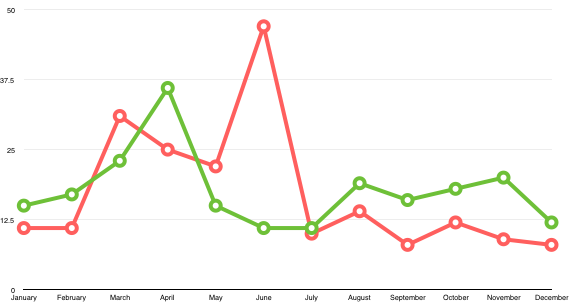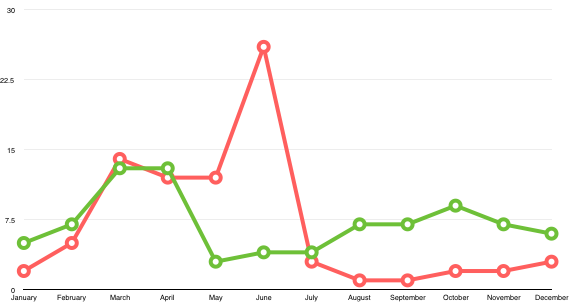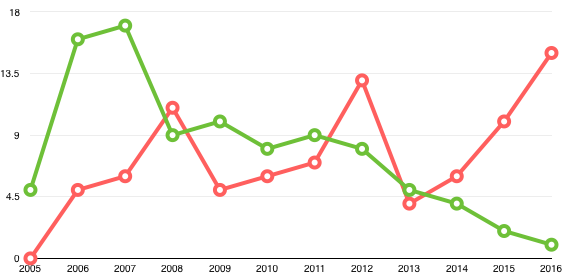I have a little more data on our (now closed) English school.

This is the number of new enrolments (in green) and number of withdrawals (in red) for all students, by month. I’ll explore this in a bit more detail below.
So clearly, the most joined in April and quit in June. I have a feeling this squares with most other eikaiwa teachers’ experiences.

This is the number of new enrolments (in green) and number of withdrawals (in red) for all students by year. It’s tempting to draw the conclusion that something went very wrong around 2011, but actually what happened is our first cohort of students started getting into the latter years of elementary school or junior high around then, and we were no longer advertising outside of our website. That was also around the time we started telling inquiries to look elsewhere because a class, even if it wasn’t full, had a very good vibe that we thought would be disrupted by the insertion of a beginner. It became a problem to find ways to add 5th grader beginners to classes of 5th graders who had been with us for 3 years – retrospectively, the better business decision would have been to have a set curriculum for each grade regardless of how long they had been with us. That also would have been a clearly inferior educational decision (in my opinion, anyway) so there’s another tradeoff of many between business and pedagogy in eikaiwa.
Also, the big spike in withdrawals in 2016 is just because everyone still around when we closed our school counts as a withdrawal. We also moved to a much more visble place in 2006 and less visible place in 2014. Interestingly these don’t seem to affect statistics all that much.
Things are little more informative when you separate the statistics for kids and adults. As in my last post on this topic, “kids” means “anyone who was in our kids’ classes at some time” – including those who stayed for 10 years and quit as college students. “Adult” includes those people as well, in addition to those who joined and quit as adults.

This is the kids by month. What I find a bit encouraging about this is that June is about a month after high school and JHS kids have settled on an extracurricular club, and have tried to keep their heads above water for at least a bit before throwing in the towel. I remember one incidence of this very clearly – teenage girl who had been with us since 7 years old, commuting to another city for HS every day, who tried to make it work with us despite needing to be on campus until at least 6 pm every evening for sports. She finally had to let us go but it wasn’t for lack of trying.
By the way two of my least favorite expressions in Japanese are 部活 bukatsu “paramilitary-style sports clubs designed to take up maximum time with minimum improvement” and 落ち着いたら ochitsuitara “when things calm down”, which usually never happens.

Just kids by year this time. If I recall, a chain school in our town closed in 2009 (not NOVA).

Just adults by month. Interestingly enough, adults joined the most in April as well. Is that because they had just started a new job in our little hamlet, or are these the kids who joined in elementary and stuck around long enough to be categorized adults? I would guess so.

And adults by year. You know, I’m struggling to remember anything of consequence that happened in 2012 and drawing a big blank. Maybe our karma was bad that year? Or something to do with the zodiac?
If there are major business lessons you can draw from our patterns of new enrolments and quittings, they might be:
- Plan your curriculum to absorb students of wildly different skill levels if you want a consistent number of students, and sort by age rather than ability. Otherwise be prepared for a lot of classes to be underenrolled simply because the students in them are too advanced for new students of the same grade level.
- Students join near the start of the school year and quit shortly after. If you have a school that locks kids into classes at the start of the academic year, it behooves you to leave a bit of flexibility until early summer so you can still move kids around after the last quitters have left for the eikaiwa Valhalla that is juku and bukatsu.
As always, decisions you make in light of this data (these data for any Greeks reading) should be made with the kind of school you want to run in mind. I’m actually glad we restricted enrolment the way we did; having close relationships with (smaller) groups of students is closer to our educational ideal than reaching more kids less deeply. If you own a school, you can make your own decision on this point. Just remember to blog about it later.
2 thoughts on “OC English by the numbers, pt. 2”